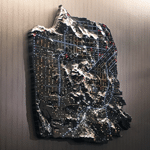
About Stanley Saitowitz
The design principal at Natoma Architects in San Francisco works in commercial, residential, and institutional architecture, and his work is internationally recognized. He was born in Johannesburg, South Africa and is a professor at the University of California at Berkeley.
The W Brand is now focused on making each hotel particular to its local context. For the San Francisco W, we have developed a concept based on a quote from native poet Ambrose Bierce. “This city is a point upon a map of fog.” ‘Map’ and ‘fog’ are the key elements that are expressed in the design.
One memorable aspect of San Francisco is its cubic buildings that are extruded from the grids of streets and lots, stretched out over the landscape like some encrusted map. The other is the fog that rolls in and out of the city, enveloping it like a living glacier.
The ground and sky become the floor and the ceiling of the W Hotel design, the floor is the map of the city, the ceiling the fog. Out of the grid of the floor, furniture as buildings are extruded; over the windows that wrap the space along Howard and Third Streets the fog descends; and along the interior wall, the city climbs upward.
The patterned carpet on the floor reflects the grids of streets and lots, and the design continues up the interior walls as backlit wooden panels. The reception desks, furniture, bars, tables, seats, and couches are cubic extrusions from this carpet map. Each piece of furniture is a fragment of the San Francisco cityscape, recreated as an interior landscape, to be sat on or in, to support the functional elements of the hotel.
These pieces of the remade interior city are enveloped in patterns of fog that cover the windows, walls, and ceilings; they are backlit and shimmering, making them both ephemeral and focal. Fog is presented as fabrics, drapes, and pixilated wall coverings that wrap the surfaces. As one goes higher in the interior, upstairs to the bar, the fog thickens and the colors change to white and mute.
The new interior of the W is a fantasy cityscape—an image of the city as remembered in movies and songs, shrouded in glowing fog.

